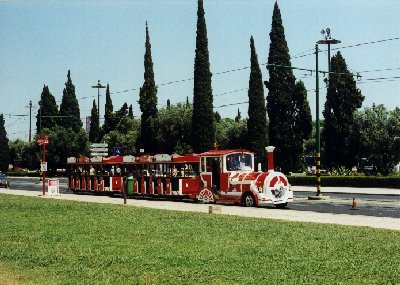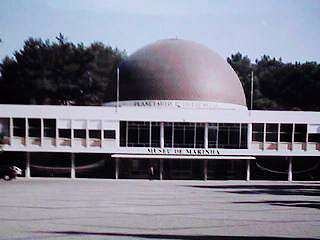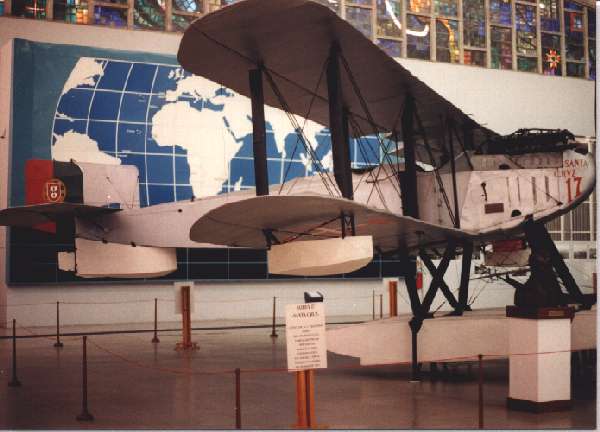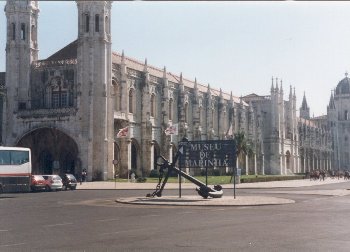Location

The Museu de Marinha lies in the Praça do Império, at Belém (tel:351/1/3620010) and occupies the north and west wings of the Jerónimos monastery. Strictly speaking its name translates as the Navy Museum but its contents do include the history of commercial vessels as well. It can be reached by alighting
from the no.15 tram from central Lisbon at the stop for the
Centro Cultural de Belém (Belém Cultural Centre). The Belém Cultural Centre itself is well worth a visit, not least for the fine view from
its cafeteria's roof terrace which looks out towards the Tagus, across
the railway line to Cascais. Alternatively, the Museu can
be reached by train; it lies about ten minutes' walk, to the west,
from Belém station which is on the Cascais
Line, which starts at Cais do Sodré. The Museu de Marinha is open
from 1000 till 1700 (1800 in summer), but is closed on Mondays
and public holidays.
Origins and Facilities
The Museu de Marinha was founded by King Luís on 22 July,1863 and was
originally housed in the Naval School in Lisbon. A major fire
destroyed most of its collection of ship models in 1916. From
1948-62 the Museum was housed at Laranjeiras, in north west Lisbon,
in the palace of the Count of Farrobo. On 15 August 1962 the collections
moved to their present location, to which has been added a
modern pavilion filled with the museum's larger exhibits. Between
this extension and the main collections, under a covered walkway, lies the
Calouste Gulbenkian planetarium, which is also open to the public.



L to R: The Museu de Marinha's open-air section and the Gulbenkian
Planetarium; the Royal brig of 1780; the Fairey seaplane in which Gago Coutinho and
Sacadura Cabral completed the first crossing of the South Atlantic, to Brazil, 1922.
The present site of the museum is close to the chapel of Our Lady
of Belem in which Vasco da Gama prayed before undertaking his historic
voyage to India in 1497. The Museu de Marinha has a café, bookshop
and produces an excellent colour guide booklet, entitled
Museu de Marinha: Visitor's Guide.
Collections
The Museum has some 17,000 items and an extensive archive which
includes 30,000 photographs. Its permanent display comprises about
2,500 items. These include magnificent collections of ship models
covering every era from the 15th and 16th-century Voyages of Discovery to
modern super-tankers.
The main part of the Museum is displayed in themed rooms, many of which are themselves
architecturally striking and hung with oil paintings of
explorers and historical events. In the entrance hall is a huge planisphere depicting
the Portuguese Voyages of Discovery from the 15th century onwards. Amongst the
exhibition rooms are ones dedicated to the Orient, Pleasure Craft, The Merchant Navy,
Shipbuilding, The Discoveries, The 18th Century and The 19th/20th Centuries.
In the Henrique Maufroy de Seixas Room is Seixas's collection of models,
photographs, books and drawings related to maritime history. There is also a River
Traffic Room, which includes models of traditional river craft, and a Deep-Sea Fishing
Room which commemorates Portuguese exploits off Newfoundland and Greenland.
Related to this last-named room is The Fishing Fleet Room but, perhaps, one of the most
memorable rooms is that housing the sumptuous royal quarters of the former royal yacht, Amélia.
The 1370 ton yacht was used by Portuguese royalty from 1887 until the
proclamation of the Portuguese Republic in 1910. Indeed, the yacht carried
members of the Portuguese royal family to exile, via Gibraltar. After
service as a hydrographic vessel, the yacht was decommissioned in 1938.
King Carlos and Queen Amélia's quarters were preserved and
re-erected here in the Museum.
The pavilion extension contains a number of boats and royal barges, of
which one of the most striking is the royal brig built for Queen Maria I in 1780. This
was propelled by 78 oarsmen and carried such historical figures as Edward VII and
Elizabeth II of England, the latter in 1957. Other famous passengers included
Kaiser Wilhelm II of Germany and King Albert I of Belgium. Sirius,
Also displayed are regional craft of northern Portugal, the Azores and of fishing villages such as
Nazaré. A major exhibit is the Fairey 17 seaplane, Santa
Cruz , in which Sacadura Cabral and Gago Coutinho completed their
historic flight from Belém to Rio de Janeiro in 1922, a distance
of 4527 miles, which required 62 hours 26 minutes of flying time and the
use of three separate aircraft, as two were lost en route.
The Museu de Marinha
also has its own Web site. To get between the various sights of Belém you can use the Comboio de Belém, a road-train which links the tourist highspots for a very reasonable charge of 500 escudos. Its starting point is the Jerónimos monastery but various stops are located along the route.
Other Lisbon Museums
Other museums (most of which are closed on Mondays) which are well worth a visit include:
The Air Museum- Museu do Ar next door to Alverca railway station on the Azambuja railway line from Oriente and with another branch at Sintra (Granja) airbase.
The Ancient Art Museum : Museu Nacional de Arte Antiga - Lisbon's major art gallery. Near to
tram routes 15, 18 and to Alcântara-Terra railway station.
Benfica Football Club Museum. Lisbon's most famous club has its museum at the famous Estádio da Luz in north west Lisbon.
The Carris Transport Museum at Santo
Amaro on tram route 15. Houses old trams and buses.
The Centro Cultural de Belém, includes the Berardo modern art collection.
The Ceramic Tile Museum: The Museu Nacional do Azulejo at Rua de Madre de Deus 4, on bus routes 18, 39A, 42, 104, 105. It is well worth the journey to this slightly out of town museum
The Communications Museum; Museu das Comunicações is at Rua do Instituto Industrial 16.
The Chiado Museum: Museu do Chiado, a fine museum of 19th- and 20th-century art, near Baixa-Chiado Metro station and tram route 28. Has an excellent small outdoor café
The Electricity Museum: Museu da Electricidade at Belém, near the
railway station, housed in a former power-generating station.
The Gulbenkian Museum: Museu Calouste Gulbenkian near
Palhavã and São Sebastião Metro stations. This has a world-famous collection of art and artefacts, including Egyptology and lalique-ware. Adjacent is the Museu da Arte Moderna.
The Lisbon City Museum: Museu de Lisboa in the Palácio
Pimenta at Campo Grande.
The Maritime Museum: Museu de Marinha at Belém. An excellent traditional musueum highlighting Portugal's many maritime achievements.
The Military Museum: Museu Militar, which stands opposite the main entrance to Sta Apolónia railway station. Both the interior of the building and its collections are impressive.
The Modern Art Centre: Centro de Arte Moderna at the Gulbenkian,
near Palhavã and São Sebastião
Metro stations.
The Museu de Arte, Arquitetura e Tecnologia is a striking modern building which was opened on 5 October 2016 adjacent to the Museu da Eletricidade, a former central electric generating station, near Belém railway station.
Museum of Design and Fashion: MUDE. Only opened in 2009/10 in the Rua Augusta. It was temporarily closed for refurbishment in summer 2016.
Museum of the Oriente, Museu do Oriente. This is one of Lisbon's newest museums and is housed at Alcantara near the railway line and near tram route 15.
The Popular Art Museum: Museu de Arte Popular, opposite the Centro
Cultural de Belém, a folklore museum.
Sporting Lisbon Museum. The impressive Alvalade stadium, home of Lisbon's second most famous club, is near Campo Grande metro station.
Copyright: ©
Contact: the following is not a link; please transcribe the address into your email 


 29 July, 2000
29 July, 2000





